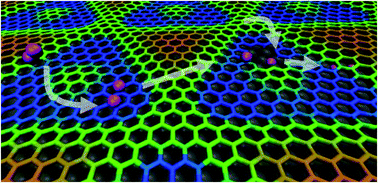Unveiling the atomistic mechanisms for oxygen intercalation in a strongly interacting graphene–metal interface†
Abstract
The atomistic mechanisms involved in the oxygen (O) intercalation in the strongly interacting graphene (G) on Rh(111) system are characterized in a comprehensive experimental and theoretical study, combining scanning tunneling microscopy and density functional theory (DFT) calculations. Experimental evidence points out that the G areas located just above the metallic steps of the substrate are the active sites for initializing the intercalation process when some micro-etching points appear after molecular oxygen gas exposure. These regions are responsible for both the dissociation of the oxygen molecules and the subsequent penetration to the G–metal interface. Unlike in other species, the DFT calculations exclude single-point defects as additional entry paths to the interface. After penetration, the intercalation proceeds inwards due to the high mobility of atomic oxygen at the interface following mid-height paths connecting the higher areas of the rippled graphene structure. At larger coverages, the accumulation of O atoms under the high areas increases the G–metal distance in the neighboring low areas, paving the way for the O incorporation and the G detachment that leads to the final O-(2 × 1) structure. Furthermore, our results show that these mechanisms are possible only at temperatures slightly lower than those in which graphene etching takes place.



 Please wait while we load your content...
Please wait while we load your content...